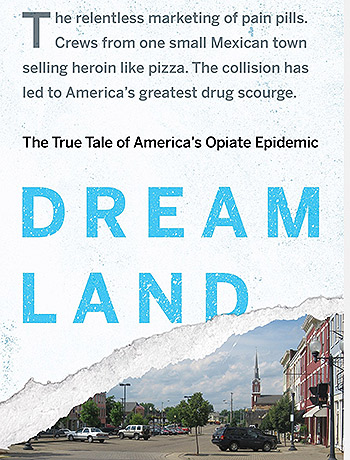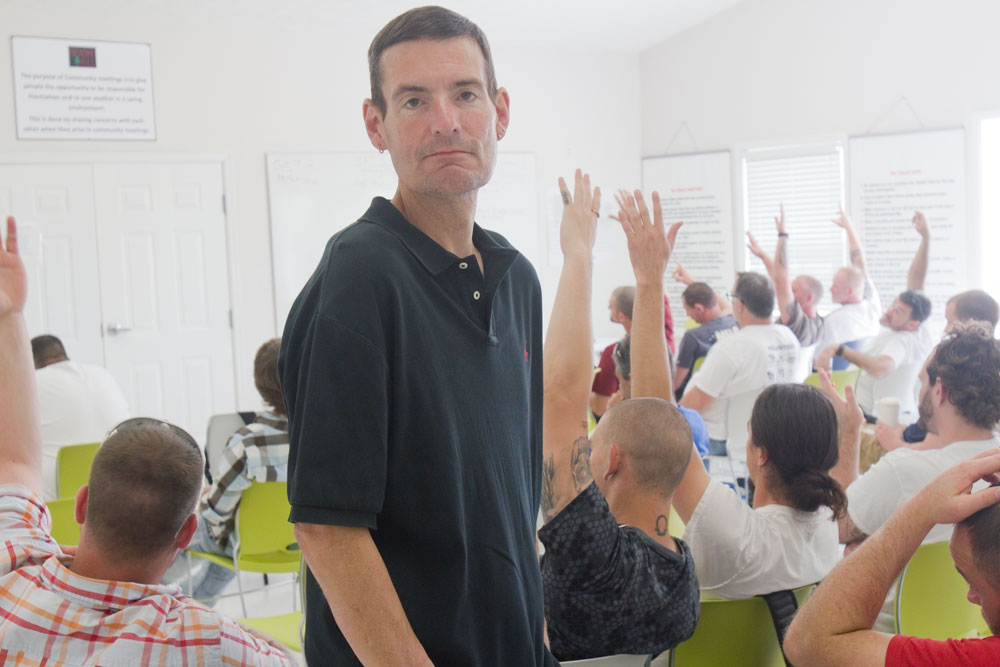 Journalist Sam Quinones tells an amazing story in his book, “Dreamland: The True Tale of America's Opiate Epidemic”: In the 1980s, Hershel Jick, a doctor at Boston University Medical Center, asked a graduate student to analyze a database of hospital records he had created to monitor side effects from drugs. He was curious about how frequently patients became addicted after being treated with pain medicines, and when her conclusions were in, he dashed off a one-paragraph letter to the editor of the New England Journal of Medicine. His last sentence read, “We conclude that despite widespread use of narcotic drugs in hospitals, the development of addiction is rare in medical patients with no history of addiction.”
Journalist Sam Quinones tells an amazing story in his book, “Dreamland: The True Tale of America's Opiate Epidemic”: In the 1980s, Hershel Jick, a doctor at Boston University Medical Center, asked a graduate student to analyze a database of hospital records he had created to monitor side effects from drugs. He was curious about how frequently patients became addicted after being treated with pain medicines, and when her conclusions were in, he dashed off a one-paragraph letter to the editor of the New England Journal of Medicine. His last sentence read, “We conclude that despite widespread use of narcotic drugs in hospitals, the development of addiction is rare in medical patients with no history of addiction.”
Jick didn’t think much more about it. But as the letter began to be cited in related articles, its findings mutated in ways that still reverberate today. Although Porter and Jick had only analyzed data from hospitalized patients in regimented settings, that detail quickly became lost in drug companies’ push to increase profits and both physicians’ and patients’ desire to relieve pain. The result was a booming market in opioid treatments administered by people at home—an entirely different scenario than analyzed for the NEJM letter. My own employer at the time—a major developer of pharmaceuticals, for which I led the communications team—was among those capitalizing on this trend. I clearly recall being told by pain specialists and corporate executives alike that aggressive, long-term prescription of opioids was the answer to too-often-undertreated chronic pain—and there weren’t any significant risks. What a win-win: We could make more money and do good at the same time.
However, that trend triggered a crisis that continues to make headlines today. Increased prescribing of opioids for legitimate, painful conditions led to long-term use and addiction, not only among the original recipients but also by those who stole or bought those drugs from patients. As the market widened (thus attracting profiteers) and, later, as a crackdown on prescribing began, cheaper analogs flooded the market—heroin and fentanyl among them, both hundreds of times more powerful than their cousins.
“The latest entrant on the street market is carfentanyl, an analog of the synthetic fentanyl. It is 100 times more potent than fentanyl and 10,000 times more potent than morphine," says comments Scott Hansel, CEO of NeighborWorks network member Community Partners and a pharmacist by education. On average, he says, 63 Palm Beach County, Florida, residents die every month from an opioid overdose.
 Community Partners is not alone in seeing such an alarming trend. Researchers from the Centers for Disease Control and Prevention shared an analysis this month showing the crisis has negatively impacted life expectancy in the United States. Published in the Journal of the American Medical Association, the report crunched the numbers recorded by the National Vital Statistics System Mortality file, a storehouse of death data from all 50 states and the District of Columbia, from 2000 to 2015. It found that the average American life expectancy lengthened, but the significant rise in opioid-related deaths shaved 2.5 months off this improvement. No other factor negatively affected life expectancy as much. While overdose deaths in the United States more than doubled in that 15-year span, opioid overdoses more than tripled, the study reported.
Community Partners is not alone in seeing such an alarming trend. Researchers from the Centers for Disease Control and Prevention shared an analysis this month showing the crisis has negatively impacted life expectancy in the United States. Published in the Journal of the American Medical Association, the report crunched the numbers recorded by the National Vital Statistics System Mortality file, a storehouse of death data from all 50 states and the District of Columbia, from 2000 to 2015. It found that the average American life expectancy lengthened, but the significant rise in opioid-related deaths shaved 2.5 months off this improvement. No other factor negatively affected life expectancy as much. While overdose deaths in the United States more than doubled in that 15-year span, opioid overdoses more than tripled, the study reported.
What can community development nonprofits do to be part of a solution? A lot actually, in widely varying ways, which the following examples from network members illustrate. As Ambassador William Brownfield, Assistant Secretary for the State Department Bureau of International Narcotics and Law Enforcement Affairs, told a meeting of the Center for Strategic & International Studies last week, “We cannot arrest our way out of this problem. It’s as much of a health and community engagement problem as one of law enforcement.”
Tackling root causes
Many addictions to opioids stem from long-term use for legitimately painful conditions—a problem exacerbated by a tendency of insurance companies to reimburse only for less-expensive, but more easily misused, versions. However, there are a multitude of other factors that contribute to opioid addiction and substance abuse in general.
“We are the only organization taking care of these individuals when they have no insurance at all,” says Andrew Wallick, a licensed social worker and director of the nonprofit’s Village for Change, which offers transitional housing and services for residents discharged from more acute programs—with stays lasting an average of five months. “We offer debt counseling, family therapy, vocational advice—whatever a client needs. We look at each resident as a holistic person.”
In addition, knowing that children with parents who struggle with substance abuse and related challenges are more likely to follow the same trajectory, Community Partners offers programs such as BRIDGES, in which families of youth referred by local schools are connected to resources such as parenting mentors. “About 70 percent of children removed from homes by the Department of Child and Family Services were exposed to substance abuse in the home,” says Wallick.
Other contributors to substance abuse, particularly in remote, rural areas, are unemployment, a feeling of isolation and a lack of productive activities. Shannon Kennelly, Communications and Outreach Coordinator for NeighborWorks of Western Vermont, says that’s why her nonprofit focuses on community building and engagement, which it considers a key piece of prevention.
“I grew up here in Rutland,” Kennelly comments. “Youth perceive a real lack of things to do with other people and a lack of opportunity, of a future here. Kids turn to alcohol and other substances to pass the time. We are trying to change that narrative by providing activities that create and strengthen the feeling of community and opportunity.”
The activities sponsored by the organization range from block parties and movie nights to longer-term jobs for teens. In the latter, youth are hired to work in a commercial kitchen associated with a farmer’s market, making muffins and other breakfast foods to sell to local schools. Employees are disadvantaged youth selected from a neighborhood targeted for revitalization, and the program typically offers them their first opportunity for steady employment. Their work is supplemented with training and education in financial literacy and other “soft skills.”
Early intervention
Substance abuse or exposure to it often begins young. Maine’s Community Concepts has responded in part by stationing alcohol and drug counselors in middle and high schools. Their effectiveness in encouraging youth to come forward is greatly enhanced, says CEO Shawn Yardley, by a state policy that allows initial consultation to take place without notification of a minor’s parents. In addition, although it is being challenged during the renewal process, the state contract funding the program currently pays for the service, avoiding a charge to the families’ insurance policies.
Hudson River Housing in Poughkeepsie, New York, is taking another approach. It has trained its staff and clients across 600 units—ranging from emergency and transitional housing, to supportive, permanent housing, to senior living—to recognize the signs of misuse, seek early help and, if necessary, administer naloxone (an opiate antidote).
“We know people are using [drugs] in our developments and programs,” says Linda Malave, Director of Resident Services and Property Management. “We’ve already had one resident save another who had overdosed and needed Narcan. Prevention is the key.”
Treatment and recovery
In January, network member Fahe received a $1 million grant from the Appalachian Regional Commission to tackle the epidemic of prescription opioid abuse in Eastern Kentucky. It will use those funds by tapping into what it does best, says President Jim King: “We’re good at developing bricks and mortar, and as an anchor institution in the region, we’re good at fostering conversation across lots of different, diverse people.”One part of its response will be to expand its development of recovery centers, which offers an 18-month life skills-training program. Three to four of the centers are currently operating and the grant will support the opening of two to three more.
“Opioids are just the ‘drug of choice’ at the moment,” notes King, echoing other nonprofit leaders who note that alcohol, for instance, is still a leading challenge. “Addiction has destroyed an entire swath of people who have fallen victim for a wide variety of reasons—with the biggies being a poor economy and lack of hope.”
Despite the fact that the recovery centers require complicated financing deals that are hard to put together—typically involving seven or eight sources of soft money—the demand is strong and growing.
In addition to the recovery centers, a task force has been formed to identify and address the barriers that prevent recovering addicts from re-entering society by finding a job and a home, thus becoming high risk for relapse. That is particularly important because, acccording to just-released research from Magellan Health in Scottsdale, more than 50 percent of patients who quit opioids for six months resume use sometime thereafter. One of the factors that can increase the risk of relapse is a criminal records, which is common among substance abusers.
“I don’t know what the extent of the overlap is,” says King. “But consider that half of the funds for operating the centers comes from the Department of Corrections. Our goal is to develop a systematic approach to easing their re-entry, counteracting all of the obstacles that keep these people from finding a place to live, work and become productive again.”

